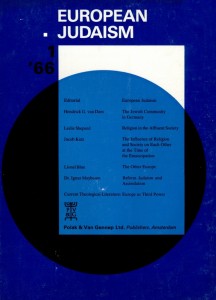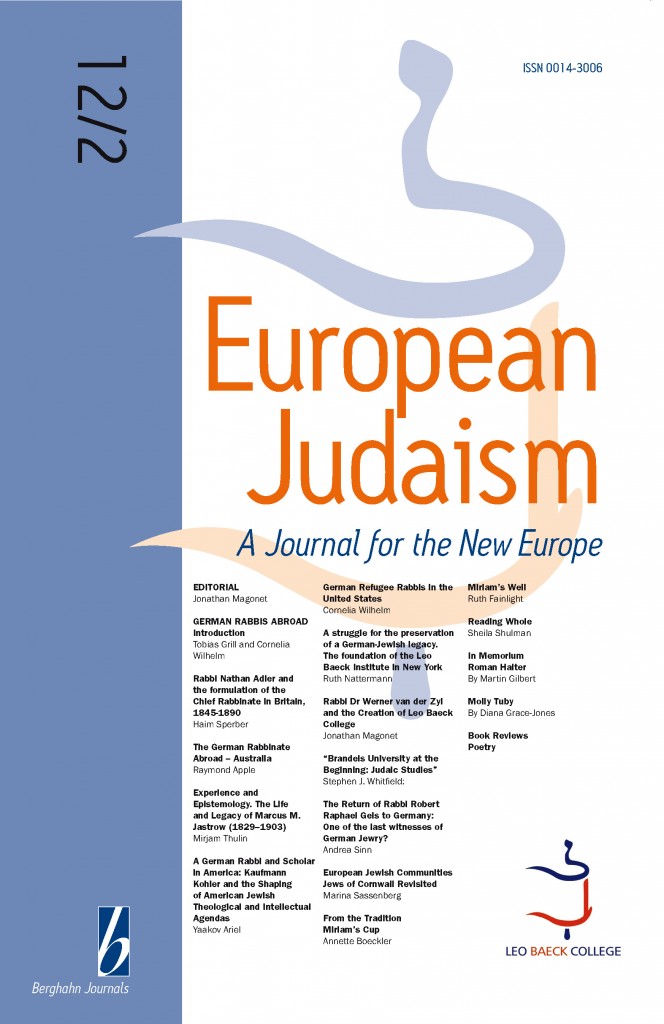For over 40 years, European Judaism has provided a voice for the postwar Jewish world in Europe. It has reflected the different realities of each country and helped to rebuild Jewish consciousness after the Holocaust. Jonathan Magonet took over as Editor in 2004. In this post, he details the foundation and evolution of the journal over its extensive history, as well as his visions for the future.
Given its title, European Judaism has to be as broad-based as its subject area. Every European country is different in history, language, culture and concerns, and the local Jewish community reflects all of these as well as its own particular experience and agenda. Yet across the European continent, there are also broader issues that have an impact on Jews, or to which Jews make significant contributions. How to reflect this complexity yet offer a (relatively) coherent voice has been the challenge faced by the editors over the journal’s now more than forty year history.
Our roots lay in the initiative of a number of young UK based Reform Rabbis, most of them graduates of Leo Baeck College, the first European rabbinic seminary created after the war. As well as the task of helping to reconstruct Jewish life they saw themselves as challenged to try to define a Jewish role and purpose in a post-Shoah Europe. The two ‘poles’ of Jewish life, then and now, were America and Israel, each with its own broadly established identity. Europe was a place of fragments and remnants of destroyed or damaged Jewish communities, struggling to re-establish some kind of normative Jewish existence, yet potentially the source of a different, perhaps mediating, Jewish voice of its own.
Over the forty years our editors have each contributed a different dimension to the breadth of the journal’s interests. Ignaz Maybaum, the founding editor, offered a broad theological perspective; his successor, Michael Goulston, was committed to addressing the questions posed by modernity to Jewish tradition and society. After Michael’s tragically early death, Anthony Rudolf continued his quest to establish a dialogue with Jewish intellectuals, many of whom were estranged from the Jewish community. His successor Marcel Marcus, in his brief tenure, encouraged the quest for a pan-European Jewish identity, which continues to be elusive given the strength of national identities. Under Albert Friedlander, the Jewish engagement in interfaith dialogue, and the changing nature of rabbinic education, including its emphasis on pastoral care and counselling, found expression in the journal. His broader role as a prominent figure in European culture opened the journal to wider perspectives and contributors.
Having been involved with the journal since my days as a student rabbi I have tried to maintain all these strands since becoming editor in 2004. My own contribution has included an interest in exploring European Jewish institutions, reflecting the emergence of post-Soviet Eastern European Jewish communities, as well as hosting areas of academic research, most recently on the state of Yiddish and Ladino studies.
For 2013 the journal has a striking new livery based on the new logo of Leo Baeck College, and the College’s new Principal Rabbi Dr Deborah Kahn-Harris joins the editorial board. Already in the pipeline are plans for an issue on French Jewry and a broader look at Jewish thinkers who have had an impact on the wider European scene.
While we continue to generate our own materials, in the last few years we have shown that the journal is a useful resource for those seeking to publish collections of conference papers that fit our broad remit, and I hope we can continue to attract such materials. I want to continue alternating themed issues with ones containing a miscellany of subjects reflecting the diversity, complexity and continuing importance of the old/new European Jewish world.
— Jonathan Magonet
To the left is the first cover of European Judaism, from 1966. On the right, the cover from the last 2012 issue. For the first issue of 2013, a new cover will be unveiled.
Berghahn Journals is pleased to announce the addition of European Judaism to JSTOR! All of the back issues, over 40 years of content, are now available online here.
For the most recent issues of European Judaism, please visit the journal’s website: http://journals.berghahnbooks.com/ej/


